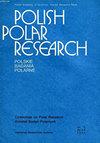小冰期以来拉普兰东北部(北纬69度)的气温和水位推断
IF 0.8
4区 地球科学
Q4 ECOLOGY
引用次数: 1
摘要
本文章由计算机程序翻译,如有差异,请以英文原文为准。
Air temperature and water level inferences from northeastern Lapland (69 degrees N) since the Little Ice Age
Independent Arctic records of temperature and precipitation from the same proxy archives are rare. Nevertheless, they are important for providing detailed information on long-term climate changes and temperature-precipitation relationships in the context of large-scale atmospheric dynamics. Here, we used chironomid and cladoceran fossil assemblages to reconstruct summer airtemperature and water-level changes, during the past 400 years, in a small lake located in Finnish Lapland. Temperatures remained persistently cold over the Little Ice Age (LIA), but increased in the 20th century. After a cooler phase in the 1970s, the climate rapidly warmed to the record-high temperatures of the most recent decades. The lake-level reconstruction suggested persistently wet conditions for the LIA, followed by a dry period between ~1910 and 1970 CE, when the lake apparently became almost dry. Since the 1980s, the lake level has returned to a similar position as during the LIA. The temperature development was consistent with earlier records, but a significant local feature was found in the lake-level reconstruction – the LIA appears to have been continuously wet, without the generally depicted dry phase during the 18 and 19 centuries. Therefore, the results suggest local precipitation patterns and enforce the concept of spatially divergent LIA conditions.
求助全文
通过发布文献求助,成功后即可免费获取论文全文。
去求助
来源期刊

Polish Polar Research
ECOLOGY-GEOSCIENCES, MULTIDISCIPLINARY
CiteScore
2.00
自引率
7.70%
发文量
0
审稿时长
>12 weeks
期刊介绍:
The quarterly Polish Polar Research edited by the Committee on Polar Research of the Polish Academy of Sciences is an international journal publishing original research articles presenting the results of studies carried out in polar regions.
All papers are peer-reviewed and published in English.
The Editorial Advisory Board includes renowned scientist from Poland and from abroad.
 求助内容:
求助内容: 应助结果提醒方式:
应助结果提醒方式:


